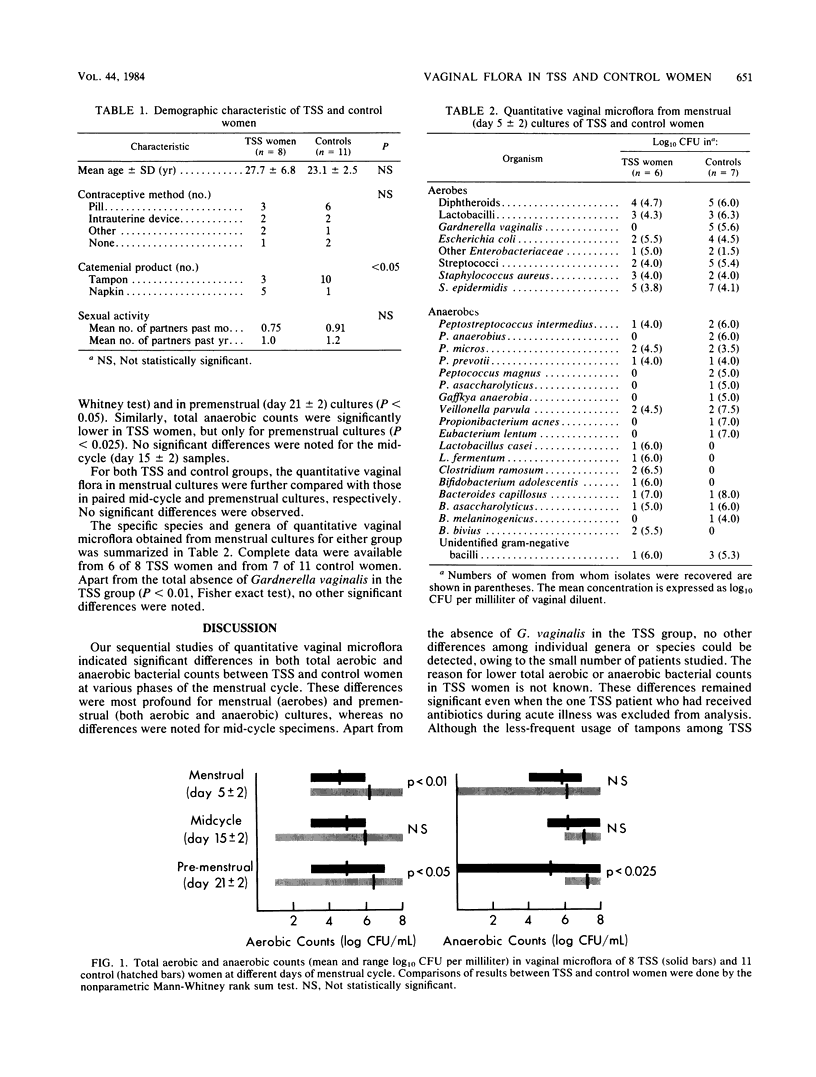Abstract
We performed sequential and quantitative vaginal cultures obtained from 8 women within 4 days to 3 years (average, 15.8 months) after their recovery from classic menstrual toxic shock syndrome (TSS) and from 11 healthy women who served as age-matched controls. Apart from tampon use, which was significantly less frequent in TSS women after their acute illness, no demographic differences were observed in the two groups. Significantly lower total aerobic and anaerobic bacterial counts were found in TSS women than in healthy controls (P less than 0.05, Mann-Whitney test). These differences were most profound during the menstrual (aerobes) and premenstrual (aerobes and anaerobes) sample times, whereas no difference in bacterial counts was observed in the mid-cycle samples. Although the less frequent usage of tampons among TSS women after their acute illness might explain the lower aerobic counts in menstrual specimens, this is unlikely to explain the significantly lower aerobic and anaerobic counts observed in premenstrual samples when tampons were not used in either group. It is possible that these differences in the quantitative vaginal microflora were a direct result of recent TSS in these women. Alternatively, disruption of the normal indigenous microflora could have predisposed these women to acute TSS by alteration of the resistance of vaginal colonization to pathogenic microorganisms.
Full text
PDF


Selected References
These references are in PubMed. This may not be the complete list of references from this article.
- Bartlett J. G., Onderdonk A. B., Drude E., Goldstein C., Anderka M., Alpert S., McCormack W. M. Quantitative bacteriology of the vaginal flora. J Infect Dis. 1977 Aug;136(2):271–277. doi: 10.1093/infdis/136.2.271. [DOI] [PubMed] [Google Scholar]
- Reingold A. L., Hargrett N. T., Shands K. N., Dan B. B., Schmid G. P., Strickland B. Y., Broome C. V. Toxic shock syndrome surveillance in the United States, 1980 to 1981. Ann Intern Med. 1982 Jun;96(6 Pt 2):875–880. doi: 10.7326/0003-4819-96-6-875. [DOI] [PubMed] [Google Scholar]
- Sanders C. C., Sanders W. E., Jr, Fagnant J. E. Toxic shock syndrome: an ecologic imbalance within the genital microflora of women? Am J Obstet Gynecol. 1982 Apr 15;142(8):977–982. doi: 10.1016/0002-9378(82)90778-5. [DOI] [PubMed] [Google Scholar]
- Sautter R. L., Brown W. J. Sequential vaginal cultures from normal young women. J Clin Microbiol. 1980 May;11(5):479–484. doi: 10.1128/jcm.11.5.479-484.1980. [DOI] [PMC free article] [PubMed] [Google Scholar]


